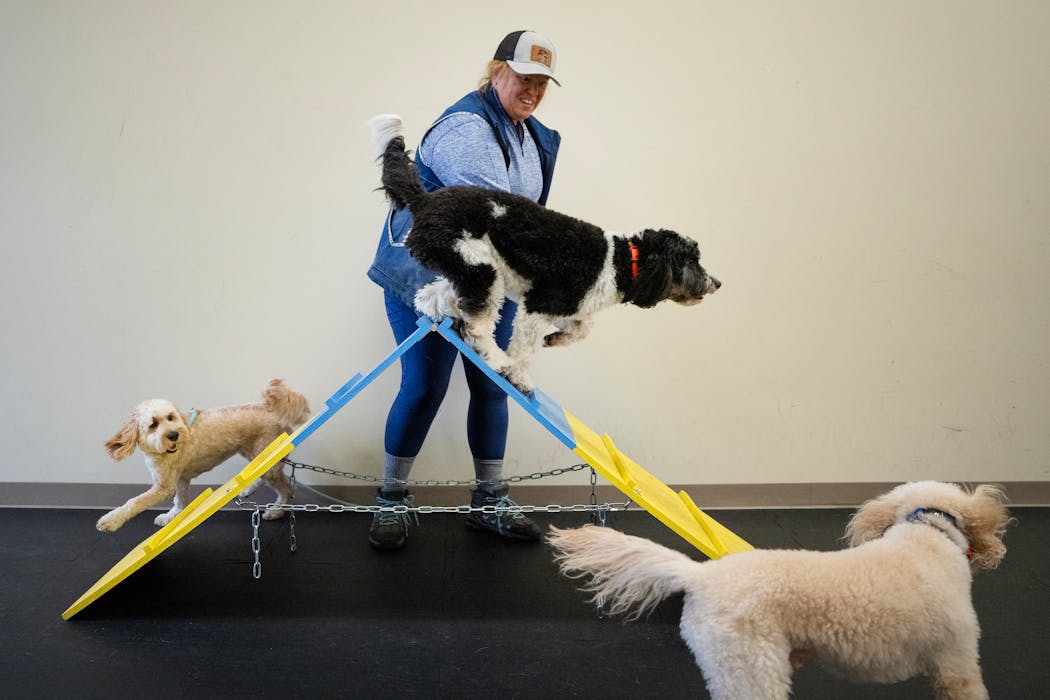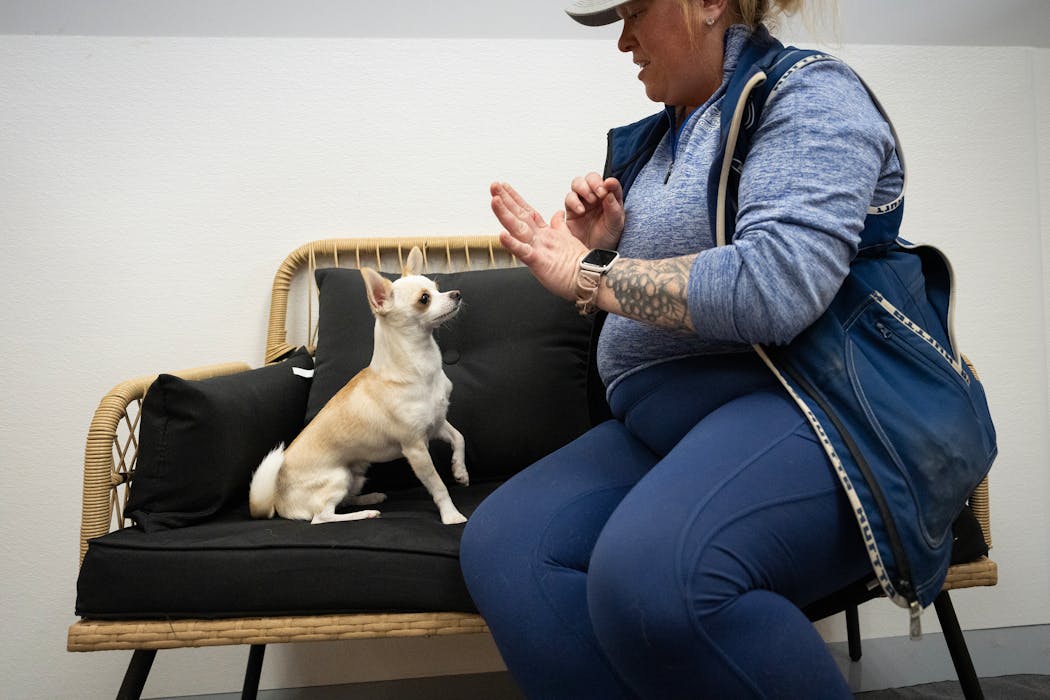When Sara Madrinich says jump, Kikka asks,"How high?"
Well, OK, Kikka doesn't actually speak those words, because Kikka is a dog, a medium-sized Dutch shepherd mix. But the canine does the next best thing when Madrinich brings her into a room furnished with dog-sized agility equipment and instructs her to jump. Kikka unhesitatingly bounds over a couple of dog-size hurdles, then looks up at Madrinich for approval.
Madrinich issues more commands, and Kikka keeps going. She scurries through a tunnel, climbs up and then down a small A-shaped ramp, weaves back and forth through a row of poles. Each time, she glances up afterward like an obedient child, proud of her accomplishment.
"She likes to learn so much," said Madrinich, who owns Adventures in Barking, a dog day care, boarding and training facility in Hopkins.
When Kikka first began her training with Madrinich about a year ago, she was considered so aggressive her owners thought she could not be around other dogs.
"We take dogs here that are known for pretty extreme aggressiveness," she said. "Dogs that have been kicked out of other facilities."
A daily schedule at Adventures in Barking is less like traditional dog day cares and more closely resembles an elementary school classroom, with stretches of learning broken up by bathroom breaks, lunchtime, playful recesses and naptime.
"You don't just drop your dog and pick her up," said Judy Boer of Victoria, whose Giant Schnauzer, Loki, has been in day care and boarding with Madrinich for more than three years. When Loki is at Adventures in Barking, "She's being challenged with whatever they decide they want to work on: leash walking, sit and stay."
Madrinich grew up in the Twin Cities and has been involved with dogs since she was 8 years old, showing dogs at Westminster Kennel Club Dog Shows. She graduated with a degree in teaching, but wasn't set on it. She moved to the East Coast and took odd jobs, became a receptionist at a dog facility in Fairfax, Va., and eventually moved into training.
So she became a teacher, after all. Just not with human students.
She moved back to Mound and about six years ago began training dogs, first at her home, then, since July, in the new Hopkins facility with its staff of seven dog trainers and plans for several more.
Dog training, Madrinich likes to say, is "more about training people than it is training dogs."
Her satisfied customers agree. "She's not just somebody who knows dogs, she knows people," said Carole Leomporra of Plymouth, who met Madrinich in 2019, when she first got her golden doodle, Rosie.
"She has great common sense and true understanding of people's lifestyles," said Darlene Richardson of Chaska, whose English cocker spaniel, Ollie, used to pull on his leash but started "doing tons better" after just a week of training with Madrinich.
We asked Madrinich for some training do's and don'ts, and other best dog practices.
On keeping it positive
Madrinich believes in positive reinforcement with treats or praise, not negative commands or punishment. She phrases her instructions in a positive or neutral way: "Leave it" to keep the dog away from something it shouldn't have, or "Go to your place," to have the dog go to a designated spot, like its bed or crate.
On common mistakes
"People tend to humanize their dogs." Madrinich said. "Don't overthink it."
Some owners expect too much, too soon, she said, such as taking their dogs to an off-leash dog park and "just hoping the dog's going to come back" after running around.
Tempting them back by shaking a bag of treats isn't a good idea, either; you want them coming to you, not the treats. During training, treats are a way of celebrating their having obeyed instructions successfully, and offered only afterward. They can eventually be phased out once the dog reflexively follows the command.
"No dog should ever be asked to do something, like, 'Do you want to sit?'" Madrinich said. "You don't need to yell at them, but be firm and to the point."
Sometimes dogs love their humans but don't respect them, she said. If a dog is barking and is told to stop, then always gets rewarded with a treat, the dog may become sneaky about it, deliberately barking to get the treat. That's when the dog has trained the human.
On best leashes
"There's no one size fits all." Harness leashes, head halters that go around the dog's muzzle and standard leashes are all fine. Madrinich uses a slip leash. Retractable leashes, however, "are trash," she said, because the owner has less control and the dog is more likely to pull on the leash rather than walk obediently beside the owner with the leash slack, the training goal.
On couches and table scraps
"At the end of the day, it's your dog," Madrinich said. If you want to let your dog lie on the furniture, that's fine (she does with her dogs). But the dog should get off the couch when commanded to do so. Similarly, it's OK to feed a dog table scraps, she said; just make the dog wait until you're done eating, not run up and grab something off your plate.
On dog personalities
"One in every 100 dogs" just can't be trained out of aggression, she said. She knew one dog that, out of the blue, bit its owner's face. The dog had been trained. "They did everything right," she said.
But that's a rare case.
Can you teach an old dog new tricks? Maybe not if it's 12 years old, nearing the end of life, and needs fairly extensive behavioral training, Madrinich said.
"Not every behavior means the same thing from one dog to the next," she said. If a dog rolls on its back, the standard interpretation is that the dog is being submissive. Sometimes the dog is just being friendly.
On 'alpha' dogs
"Alpha is kind of an old-fashioned term," Madrinich said. Multiple dogs living in the same house usually figure out among themselves who's the boss. It's not necessarily the oldest or biggest. Often, female dogs tend to be take charge, natural leaders.
"Girls love you, but boys love to love you," she said. When someone wants to buy a dog, she recommends males, because they're more eager to please. With two dogs, one of each sex is the best combination. Two males is OK, but two females are less easy. With two female dogs, both want to be the leader. "We call them bitches for a reason."
On dogs' powers of detection
Owners sometimes give dogs too much credit for detecting the inner characters of humans, Madrinich said. Their judgment isn't always accurate. Some "freak out if their owner wears a hat."
But dogs are well known for sensing fear or anxiety. Even more mysteriously, they can tell when somebody is about to have a seizure before it has started, or if a diabetic's blood sugar is high. They can even sniff out COVID.
And of course dogs know, or can be trained, to act when there's danger, the way Lassie knew to seek an adult to help when Timmy fell down a well. Or the way another smart dog, widely seen on social media, saw that an electric bike charger had started on fire and, when no human came to the rescue, wisely unplugged the charger.




